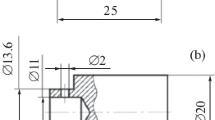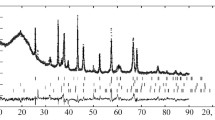Conclusions
The predominant effect on electric erosion in the first switching cycles of light currents in air is exerted by the state of the surface of the working layer of contacts (increased content of copper, its deformation, the presence of oxides, etc.) and by the predominant evaporation of copper caused by it.
The erosion of contacts in current switching in air is also affected by intense evaporation of tungsten oxides.
Enrichment of the working layer of W-Cu contacts with tungsten plays the decisive role in the course of the aggregate chemical reactions and processes causing destruction of these contacts by multiple switchings of heavy currents in air and in oil.
The effect of carbide formation and oxidation of tungsten determines the role of brittle destruction in the electric erosion of contacts.
Similar content being viewed by others
Literature cited
G. G. Gnesin (ed.), Sintered Materials for Electrical Engineering and Electronics [in Russian], Metallurgiya, Moscow (1981).
M. T. Magnusson, “Über das Abbrandverhalten von Verbundwerkshtoffen auf Wolframbasis beim Schalten grosser Wechselströme in Luft und 01,” Elektrotech Z. Ausg.,98, 681–683 (1977).
W. Haufe, W. Reichel, and H. Schreiner, “Abbrand verschiedener W-Cu Sintertränkwerkstoffe unter 01 bei hohen Strömen,” Z. Metallkde.,62, No. 8, 592–595 (1971).
W. Haufe, W. Reichel, and H. Schreiner, “Abbrand verschiedener W-Cu Sintertränkwerkstoffe an Luft bei hohen Strömen,” Z. Metallkde.,63, No. 10, 651–654 (1972).
M. A. Zhavoronkov, I. A. Lavrinenko, G. V. Levchenko, et al., “Comparative investigation of electroerosive destruction of cermet contacts under the effect of an arc in transformer oil and in air,” in: Heavy-Current Electric Contacts and Electrodes, Inst. Probl. Materialoved. AN USSR, Kiev (1972), pp. 247–258.
A. M. Mel'kumov and I. L. Shleifman, “Wear of cermet contacts under the effect of an electric arc in transformer oil and in air,” in: Heavy-Current Electric Contacts and Electrodes, Inst. Materialoved. AN USSR, Kiev (1972), pp. 241–243.
D. Stöckel, Werkstoffe für elektrische Kontakte. Kontact k (und) Stutium, Vol. 43, Becht-Druck, Ammerbuch (1980).
G. N. Braterskaya, R. V. Minakova, and O. K. Teodorovich, “Materials for electric contacts. Ways of saving tungsten and noble metals,” Poroshk. Metall., No. 3, 69–80 (1983).
I. N. Frantsevich, “Electric contacts obtained by methods of powder metallurgy,” Poroshk. Metall., No. 8, 36–47 (1980).
G. N. Zenkevich and B. V. Ioffe, Interpretation of Mass Spectra of Organic Compounds [in Russian], Khimiya, Leningrad (1986).
V. M. Chevlev (ed.). Thermophysical Properties of the Working Media of Gas-Phase Nuclear Reactors [in Russian], Atomizdat, Moscow (1980).
G. N. Aleksandrov (ed.), The Design of Electric Switchgear [in Russian], Énergoizdat (Leningradskoe Otdelenie), Leningrad (1985).
R. Hiltgren, R. L. Orr, P. D. Andersson, and K. K. Kelley, Selected Values of the Thermodynamic Properties of the Elements, Am. Soc. Met., Ohio (1973).
E. K. Kazenas and D. M. Chizhikov, Vapor Pressure and Composition of Vapors above Oxides of Chemical Elements [in Russian], Nauka, Moscow (1975).
T. Ya. Kosolapova (ed.), Properties, Production, and Application of High Melting Compounds: Handbook [in Russian], Metallurgiya, Moscow (1986).
V. P. Glushko (ed.), Thermodynamic Properties of Individual Substances (Handbook) [in Russian], Vols. 1–4, Nauka, Moscow (1978–1983).
G. H. Gessinger and K. N. Melton, “Burn off behavior of W-Cu contact materials in an electric arc,” Powder Met. Int., No. 1–2, 67–72 (1977).
V. I. Rakhovskii, Physical Foundations of the Switching of Electric Current in Vacuum [in Russian], Nauka, Moscow (1970).
Tables of Spectral Lines (Handbook) [in Russian], Nauka, Moscow (1977).
N. I. Reznikov (ed.), Machining of Heat Resistant, High-Strength, and Titanium Alloys with Cutting Tools [in Russian], Mashinostroenie, Moscow (1972).
R. V. Minakova, L. I. Kostenetskaya, A. P. Kresanova, et al., “Erosion resistance of powder materials based on high melting metals in a stationary arc,” Poroshk. Metall., No. 8, 55–62 (1983).
V. P. Ignatko, A. P. Kresanova, V. A. Kukhtikov, and R. V. Minakova, “Comparative investigations of erosion processes on copper and cermet electrodes in a heavy-current quasistationary arc,” in: Electric Contacts [in Russian], Nauka, Moscow (1972), pp. 71–74.
M. Nicolas and D. M. Poole, “The influence of oxygen on wetting and bonding in Cu-W system,” J. Mater. Sci.,2, No. 3, 269–274 (1967).
R. S. Belkin and M. E. Danilov, “Investigation of the special features of electric erosion of cermet materials,” Elektrichestvo, No. 8, 45–48 (1972).
G. V. Butkevich, G. S. Belkin, N. A. Vedeshenkov, and M. A. Zhavoronkov, Electric Erosion of Heavy-Current Contacts and Electrodes [in Russian], Energiya, Moscow (1978).
Author information
Authors and Affiliations
Additional information
Translated from Poroshkovaya Metallurgiya, No. 1(313), pp. 51–57, January, 1989.
Rights and permissions
About this article
Cite this article
Minakova, R.V., Fenochka, B.V. & Kresanova, A.P. Special features of the wear of tungsten-copper electric contacts in air and in oil. Powder Metall Met Ceram 28, 43–48 (1989). https://doi.org/10.1007/BF01171807
Received:
Issue Date:
DOI: https://doi.org/10.1007/BF01171807




